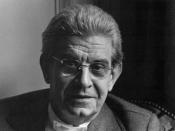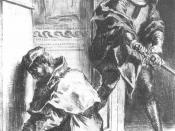Although O'Neill derived Mourning Becomes Electra from the Oresteia, the myth that actually structures the play's action is overwhelmingly that of Oedipus.
The Oedipal drama, and Freud's elaboration of it, determines the course of the trilogy. Lavinia, for example, yearns to replace Christine as wife to her father, and mother to her brother. Christine clings to Orin, and Brant is but a substitute for her precious son. Orin also yearns to re-establish his incestuous bond with his mother.
The predominant pair of lovers in the play, is the mother/son. The players continually become substitutes for these two figures that organize their family history. This is made most explicit in Lavinia and Orin's reincarnation as Christine and Ezra.
The various substitutions among the characters as structured by the Oedipal drama make them each other's doubles. The double is also the rival- the player who believes himself dispossessed is convinced that his double stands in his proper place.
For example, Lavinia considers Christine to be the wife and mother she should be, and the play's male characters vie for the desire of Mother.
The Civil War, generally remembered as a war between brothers, comes to symbolize this struggle. The men's rivalries are murderously infantile, operating to a jealous logic of "either you go, or I go".
In the Oedipal myth, what tears the son away from his incestous embrace with his mother is the imposition of the father's law. Ezra serves as a figure for this law in a symbolic manner, namely after his death when he exercises his 'law' with all the more force, whilst haunting in his various forms. Christine cringes before his portrait (in which he's symbolically wearing judge's robes), and Lavinia invokes his voice and name to command Orin to attention.
The symbol that dominates the playing...


